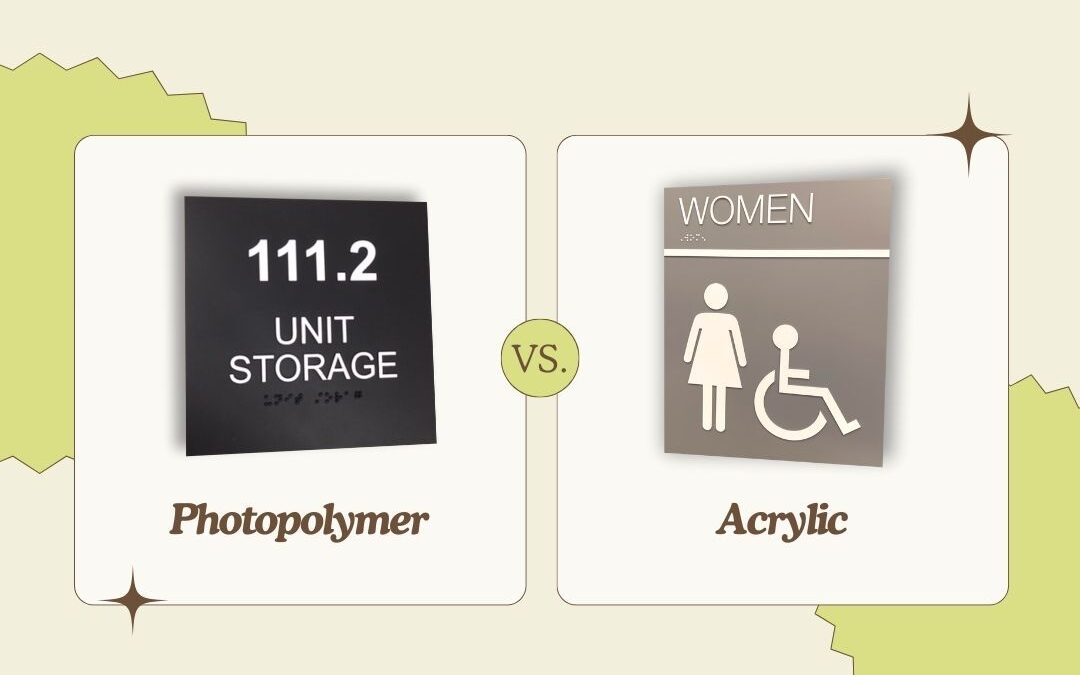When it comes to ADA Braille signage for schools, choosing the right material can make a significant difference in terms of cost, production time, and overall aesthetic. Two of the most popular materials used in the industry are photopolymer and acrylic. While both meet ADA standards and serve the same fundamental purpose, they have distinct differences that could influence your decision.
Photopolymer ADA Braille Signs: Durability and Design Flexibility
Photopolymer signs are known for their one-piece construction. In these signs, the letters and Braille are integral to the sign, meaning they are not separate elements added on but are formed as a single piece. This gives photopolymer signs exceptional durability, as there are no glued or attached components that could potentially wear out, become damaged, or separate from the sign over time.
However, this durability comes at a cost. Photopolymer signs generally take so much longer to produce and are more expensive. One of the reasons for this is that photopolymer signs are typically painted, which not only adds to the production time but also increases the cost. The upside is that the painting process allows for greater freedom in color choices, enabling schools to match signs to their branding or specific color schemes.
Acrylic ADA Braille Signs: Speed and Cost-Effectiveness
On the other hand, acrylic ADA Braille signs offer a more budget-friendly and time-efficient option. Acrylic signs are more readily available, less expensive, and can be produced much quicker than photopolymer signs. While acrylic signs can also be painted if that’s the desired effect, offering the same level of color customization as photopolymer signs, they don’t have to be in order to achieve the final look. So the real beauty of acrylic lies in its versatility, availability, and affordability.
Acrylic signs can be made from colored non-glare acrylics that don’t require painting, which significantly reduces production time and cost. These pre-colored acrylics are ready to use as soon as the signs are assembled, making them an ideal choice for schools that need signs quickly. This option not only saves time but also provides a durable, attractive finish that meets ADA standards. The materials being readily available also help when needing to order additional signs in the future and ensure a variety of vendors can provide them when needed without minimums or overwhelming set up fees.
Which One is Right for Your School?
When deciding between photopolymer and acrylic ADA Braille signs for your school, consider the specific needs of your project. If durability and a fully customizable color scheme are your top priorities and you have the budget and time to accommodate, photopolymer signs may be the way to go. They offer long-term resilience and a premium finish that can be tailored to your school’s exact specifications.
However, if you’re working with tighter time constraints, a more limited budget, or know you might need to order additional signs in the future, acrylic signs offer an excellent alternative. Their quick production times and cost-effectiveness make them a popular choice for schools looking to meet ADA requirements without breaking the bank. Plus, with the option of using colored non-glare acrylics, you can still achieve a professional, polished look with minimal effort.
Conclusion
Both photopolymer and acrylic ADA Braille signs have their unique advantages. Understanding the differences between these materials will help you make an informed decision that meets your school’s needs, whether you prioritize durability, design flexibility, or cost-effectiveness. No matter which option you choose, both types of signs will ensure your school is compliant with ADA standards, providing accessible and functional signage for all students, staff, and visitors.

